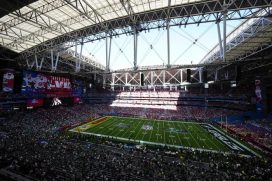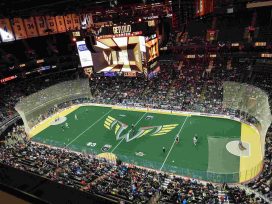This is the third installment of a three part series analyzing the Eagles quarterback situation. In Part I, I broke down how it is virtually impossible for the Eagles to get Marcus Mariota in the draft. In Part II, we examined the lack of options available in free agency and through trades.
So where does that leave us? Nick Foles, of course.
But before getting to Nick Foles, let's have some context, shall we? What do we need at the quarterback position to realistically compete for a Super Bowl? Turn on any NFL show and you will hear experts claim that you need either an elite franchise caliber quarterback (i.e., a top 5 guy) or a great defense to win a Super Bowl. I've heard it so often I accepted it as true. But it simply is not supported by recent history.
Here is a breakdown of the quarterbacks to have played in the last 14 Super Bowls. In parenthesis are the quarterbacks DYAR and DVOA rankings, respectively, from Football Outsiders. I focused on the last 14 years because the changes to the leagues rules regarding pass interference and defensive holding make this a much different league than 20 years ago. Also, I included both winning and losing quarterbacks because the Super Bowl is largely a crap shoot. Once you get to the Super Bowl, anything can happen (as the New York Giants two recent Super Bowl victories showed us).
|
Year |
QB (DYAR / DVOA) |
QB (DYAR / DVOA) |
|
2000: |
Baltimore: T. Dilfer (39th / 39th) |
New York: K. Collins (8th / 9th) |
|
2001 |
New England: T. Brady (13th / 12th) |
St. Louis: K. Warner (1st / 1st) |
|
2002 |
Tampa Bay: B. Johnson (10th / 11th) |
Oakland: R. Gannon (1st / 4th) |
|
2003 |
New England: T. Brady (9th / 13th) |
Carolina: J. Delhomme (18th / 23rd) |
|
2004 |
New England: T. Brady (4th / 4th) |
Philadelphia: D. McNabb (6th / 6th) |
|
2005 |
Pittsburg: B. Roethlisberger (10th / 15th) |
Seattle: M. Hasselbeck (30th / 31st) |
|
2006 |
Indianapolis: P. Manning (1st / 1st) |
Chicago: R. Grossman (29th / 29th) |
|
2007 |
New York: E. Manning (40th / 34th) |
New England: T. Brady (1st / 1st) |
|
2008 |
Pittsburg: B. Roethlisberger (26th / 27th ) |
Arizona: K. Warner (5th / 8th) |
|
2009 |
New Orleans: D. Brees (4th / 3rd) |
Indianapolis: P. Manning (3rd / 5th) |
|
2010 |
Green Bay: A. Rodgers (4th / 4th) |
Pittsburg: B. Roethlisberger (7th / 2nd) |
|
2011 |
New York: E. Manning (8th / 9th) |
New England: T. Brady (3rd / 3rd) |
|
2012 |
Baltimore: J. Flacco (17th / 17th) |
San Francisco: C. Kaepernick (13th / 3rd) |
|
2013 |
Seattle: R. Wilson (9th / 8th) |
Denver: P. Manning (1st / 1st) |
|
Avg. |
14th / 14th |
9th / 9th |
Some thoughts on these numbers:
- Only 4 times in the last 14 years has a QB ranked in the top 5 of DVOA and DYAR won the Super Bowl.
– Compare that with the 8 quarterbacks that won the Super Bowl who ranked outside the top 10 in either DVOA or DYAR.
– In other words, twice as many quarterbacks outside the top 10 have won a Super Bowl as those inside the top 5. That's a startling number.
- Brady is considered one of the best quarterbacks of our generation. Yet, he ranked in the top 5 of DVOA and DYAR in only one Super Bowl victory. In his first two Super Bowl victories, he averaged outside the top 10 in both categories. In his two Super Bowl loses? He ranked 1st and 3rd respectively.
- Eli Manning and Ben Roethlisberger, who have fallen in the top 15 range for their career, have won more Super Bowls than Aaron Rodgers, Peyton Manning, and Drew Brees combined.
- The Super Bowl winning QB was, on average, ranked 5 spots lower than the Super Bowl losing QB.
– Similar numbers apply to the Super Bowl losers: 7 out of 14 (50%) of Super Bowl runners up were ranked outside of top 5 of DVOA and DYAR.
It is important to distinguish what these numbers do and do not tell us. These numbers do NOT say that elite quarterbacks are overrated. Having Peyton Manning, Tom Brady, Drew Brees or Aaron Rodgers dramatically increases your chances for regular season success, since the number of games all but ensures that the best teams rise to the top.
But these numbers DO tell us that an elite signal caller is not a prerequisite to winning a Super Bowl. Remember, the average DVOA and DYAR ranking for Super Bowl winning quarterbacks over the last 14 years was 14. And 71% of the last Super Bowls were won by a team with a quarterback that ranked in the top 15 of DVOA and DYAR that year. So if the rest of your team is good enough, history shows us you can realistically compete for a Super Bowl with a quarterback in the top 15.
This should put into proper context the manner in which we judge Nick Foles. We should not be writing Nick Foles if he isn’t a top 5 guy. We need to ask ourselves whether Foles is a guy that can consistently rank in the top 10-15 quarterbacks in the NFL, such that we can build a team good enough to win it all.
I think when we judge Foles through that context, it makes the answer readily apparent: at a minimum, he is the solution for 2015. Many people in Philadelphia are not buying it. They think 2014 is more indicative of his talents than 2013 and have labeled him an “average” quarterback on par with the likes of Mark Sanchez (I’m looking at you, Josh Innes).
But to reach that conclusion, you would have to do two things:
- Completely write off 2013 as a “fluke” season, a statistical aberration that has no bearing whatsoever on his abilities as a quarterback.
- Ignore mitigating circumstances that hampered his productivity in 2014; namely, the injuries along the offensive line, the ineffective run game, and his tough strength of schedule.
You simply cannot do either of those things and claim to be objectively evaluating Foles as a prospect.
To be clear: I am not saying that Nick Foles is the Eagles long term answer at quarterback. Rather, I am saying that we lack enough information to say that Nick Foles is not the long term solution. Those are separate and distinct questions. And as we saw in Parts I and II of this series, there are not any realistic options available for the Eagles in free agency, the draft, or through trades to upgrade the position. So for at least 2015, Nick Foles represents the best option for the Eagles.
Let’s break it down further.
Foles By The Numbers
Let’s take a look at Foles numbers the last two years:
|
Year |
2013 |
2014 |
|
Record |
8-2 |
6-2 |
|
Cmp % |
64.0 |
59.8 |
|
Yds |
2891 |
2163 |
|
TD |
27 |
13 |
|
TD% |
8.5 |
4.5 |
|
Int |
2 |
10 |
|
Int% |
.6 |
3.2 |
|
Y/A |
9.1 |
7.0 |
|
Y/G |
270.4 |
270.4 |
|
Rate |
119.2 |
81.4 |
|
QBR |
69.04 |
62.21 |
|
DYAR |
1,011 |
280 |
|
DVOA |
35.6% |
2.0% |
Put them together, and you get this: a 25 year old quarterback with a 14-4 record under Chip Kelly, completing 61.9% of his passes, and 40 touchdowns and 12 interceptions.
Yes, I went bold font on you. Sometimes it's easy to forget just how successful he has been.
In 2013, Nick Foles ranked 2nd in the league in terms of DVOA, behind only Peyton Manning, who also had a historic season statistically. He also ranked 5th in the league in terms of DYAR, ahead of Tom Brady, Tony Romo, Aaron Rodgers, and Andrew Luck, to name a few.
At the end of the season, Foles’ critics were quick to point out that he played above his talent level, and that it should be expected for him to regress back to the mean. And as you can see, those predictions proved to be true if you consider the numbers in a vacuum.
But we do not operate in a vacuum. We operate in reality. And reality tells us that several mitigating factors impacted Foles ability to succeed.
Offensive Line Injuries
First, the Eagles offensive line was a mess. He played four games without Lane Johnson. He had just one game with Evan Mathis. He had just four games with Jason Kelce. Todd Herramens played two games with a torn biceps muscle. Allen Barbe, who was supposed to fill in for the suspended Johnson, played just one game, meaning Foles was playing with a third string tackle. The Eagles benefited from unprecedented health along the offensive line in 2013. In 2014, karma came back to bite them because they suffered an inordinate amount of injuries to the unit. And it undoubtedly impacted his ability to play effectively.
Run Game Struggles
It should be a shock to no one that the running game struggled as a result of the offensive line injuries. In the first seven games (all started by Foles), the Eagles averaged only 99.43 yards per game on the ground. In the following 5 games, with the line finally healthy, the Birds averaged a stellar 150 yards per game. Everyone was willing to accept that the injuries hurt the running game. Why weren’t they willing to extend that same concession to Nick Foles?
Increased volume
In 2013, with a healthy run game, Foles only threw the ball 24.38 times a game. In 2014, with no run game to speak of, that number dramatically increased to 38.75 times per game. And while some of Foles turnovers this season were simply inexcusable, basic math tells us that the more a quarterback throws the ball, the more opportunities exist for turnovers to occur. That is especially true if a defense does not have to respect the run game and can key on the passing game. Which is precisely the type of scenario Foles faced during the first 7 games of the season.
Nick Foles Upside
Despite the success of the Eagles offense in 2013, many fans believe that Chip Kelly's offense needs a mobile quarterback to be successful. While a mobile quarterback certainly wouldn't be a bad thing, it cannot override the importance of having a guy that can make quick, decisive reads and deliver the ball with "reptitive accuracy." The best supplement to a lack of mobility is the ability to throw the ball deep. It keeps the defenses honest and prevents them from completely selling out on the run. Nick Foles excelled with the deep ball in 2013, but was less successful in 2014. If he is able to revert back to 2013 form, his lack of mobility will be a non-issue. And while he struggled in this area in 2014, he still made throws like this:
Comparable Quarterback Struggles
While Nick Foles’ 2013 season was one for the ages, his struggles in 2014 were actually quite common for franchise caliber quarterbacks. I went back and studied NFL quarterbacks that would fall into that top 10-15 range, and outside of Aaron Rodgers, almost every quarterback regressed at one point or another in his career. As you will see, a lot of that had to do with – you guessed it – injuries to the quarterbacks team. And while I am not putting Foles on these quarterbacks level (yet), at a minimum it shows us that one down season does not a career make.
Peyton Manning
At the start of the 2001 season, Peyton Manning was the hottest young quarterback in the NFL. He lead the Colts to consecutive seasons in the playoffs, having gone a combined 23-9 in the prior two years. However, look at the drop off in his numbers from 1999 and 2000 to 2001:
|
Year |
1999 |
2000 |
2001 |
|
Record |
13-3 |
10-6 |
6-10 |
|
Cmp % |
62.1 |
62.5 |
62.7 |
|
Yds |
4135 |
4413 |
4,131 |
|
TD |
36 |
33 |
26 |
|
TD% |
4.9 |
5.8 |
4.8 |
|
Int |
15 |
15 |
23 |
|
Int% |
2.8 |
2.6 |
4.2 |
|
Y/A |
7.8 |
7.7 |
7.6 |
|
Y/G |
258.4 |
275.8 |
258.2 |
|
Rate |
90.7 |
94.7 |
84.1 |
|
QBR |
Unavailable |
Unavailable |
Unavailable |
|
DYAR |
1,581 |
1,888 |
965 |
|
DVOA |
34.6% |
38.3% |
14.7% |
You can see that while his yards and touchdowns largely stayed the same, his interception rate spike dramatically from 2.7 to 4.2, and his quarterback rating dropped almost 8 full points. (By the way, that 4.2% interception rate was almost a full point higher than Foles’ rate for 2014). So what happened? In 2001, injuries hit the Colts, Manning struggled, and the bottom fell out, culminating in a 6-10 record and everyone wondering what was wrong with the golden boy.
Sound familiar?
Ben Roethlisberger
How about two-time Super Bowl champion Ben Roethlisberger? Compare his 2007 with 2008 performances:
|
Year |
2007 |
2008 |
|
Record |
10-5 |
12-4 |
|
Cmp % |
65.3 |
59.9 |
|
Yards |
3154 |
3301 |
|
TD |
32 |
17 |
|
TD% |
7.9 |
3.6 |
|
Int |
11 |
15 |
|
Int% |
2.7 |
3.6 |
|
Y/A |
7.8 |
7.0 |
|
Y/G |
210.3 |
206.3 |
|
Rate |
104.1 |
80.1 |
|
QBR |
72.2 |
42.11 |
|
DYAR |
668 |
97 |
|
DVOA |
12.7% |
-10.2% |
His numbers were down across the board. Now let’s compare Big Ben’s 2008 season to Foles’ 2014 season:
|
|
Big Ben |
Foles |
|
Record |
12-4 |
6-2 |
|
Cmp % |
59.9 |
59.8 |
|
Yds |
3301 |
2163 |
|
TD |
17 |
13 |
|
TD% |
3.6 |
4.5 |
|
Int |
15 |
10 |
|
Int% |
3.6 |
3.2 |
|
Y/A |
7.0 |
7.0 |
|
Y/G |
206.3 |
270.4 |
|
Rate |
80.1 |
81.4 |
|
QBR |
42.11 |
62.21 |
|
DYAR |
97 |
280 |
|
DVOA |
-10.2% |
2.0% |
Foles’ numbers don’t look so bad now do they? Virtually identical completion percentage, but much better numbers across the board: higher touchdown percentage, better interception percentage, more yards per and dramatically better DYAR and DVOA ratings. And for those of you that forgot, the Steelers won the Super Bowl in 2008, despite how poorly Big Ben played. This is not to say that the Eagles would have won the Super Bowl had Foles stayed healthy. But they were 6-2 with him as a starter and were just starting to get healthy along the offensive line. So they could have continued that success despite his inconsistent play.
Philip Rivers
Philip Rivers had a similar dip in production from the 2009 to 2010 season. Following a season in which he threw 30 touchdowns to just 13 interceptions, Rivers numbers fell across the board, with 27 touchdowns, 20 interceptions, and 3.4 interception rate that was actually worse than Foles this year (3.2%). The Chargers were decimated by injuries in 2010, tying an NFL record with 74 injuries. Again, sound familiar?
I won’t belabor the point, but there are a host of other quarterbacks who have gone through similar struggles only to rebound the following year. This is not to say that Foles is on Manning, Big Ben or Rivers' level (yet). But it’s safe to say that Nick Foles isn’t the only quarterback in NFL history to have struggled for a season. And it’s equally safe to say that one subpar season is not going to define his career.
So let’s recap:
– An elite signal caller is not required to win a Super Bowl, as only 4 quarterbacks in the top 5 of DYAR and DVOA that year won a Super Bowl.
– However, you want a guy that ranks in the top 15, as 10 of the last 14 Super Bowl winning quarterbacks were ranked in the top 15 categories of DYAR and DVOA
– Nick Foles has shown he can be a top 15 guy (at a minimum). In 2013, he was a top 5 guy in both DVOA and DYAR.
– His 2014 season was affected by a number of things, including the injuries to the Eagles offensive line, a limited run game, and his higher usage rate. Despite those extenuating circumstances, he still finished the year 15th overall in QBR. Since the run game improved dramatically after the offensive line became healthy, it is reasonable to assume that Foles' play would have also improved. With the Eagles sitting at 6-2, anything could have been possible.
- Foles is14-4 as a starter under Chip Kelly.
- And he is not alone in having off season; Peyton Manning, Big Ben, Philip Rivers, just to name a few, have all had down seasons during their careers.
Considering he is signed on a team friendly deal, and there aren't any viable options in the draft, free agency or through trades, the Eagles should stick with Foles and build a better team around him instead of mortgaging the future on Mariota (or any other quarterback).







